
Welcome back to another Sunny Mary Meadow podcast/blog post. Today we are going to talk about one of my favorite flowers to grow … zinnias. I will be honest, though, I have a bit of a love-hate relationship with them because they take forever to harvest compared to other flowers. I don’t know why … I think it’s because you have to cut them so low, you have to test them out, etc. You can’t just look at them and see if they’re ready to harvest. You have to actually feel them and wiggle them back and forth a little bit. So, they just take longer to harvest, but they are such a workhorse.

For example, if I’m doing a stem bar, either one at my farm or one of the ones I do at breweries, I will bring 15 buckets of flowers, three of which will be zinnias. I want every single bouquet to have two to four zinnias because they add so much volume. In our last post/episode, I talked about my bouquet-making recipe, and I said you need some discs (circle-shaped) flowers to fill stuff out and add more volume. That’s where zinnias come into play. There are certain varieties that are showstoppers because they’re just huge, and that’s actually your focal flower. They just add so much, so I love them. As I said, harvesting takes a little while, so that’s annoying, but I just love them. I think most flower farmers will agree that “Yep, they’re just a huge workhorse.”
Here’s a little bit about them … they’re an annual. I also grow a lot of perennials, but these are an annual. You can start them inside in seed trays and transplant them out, but honestly, I feel like I only get an extra week or two of them, and it takes a lot of work to start them in trays and transplant them. I’d rather just pop the seeds directly into the ground. So, I do nine-inch spacing and usually put two seeds in every hole. They’re pretty big seeds. I will actually let my five-year-old, Vidalia, plant them because she does a pretty good job at it. You just plant them an inch deep and then cover them up, and that’s all you have to do. They just pop up, it’s great. If you live in a climate that’s different than mine, you may need to start them in seed trays. For my business, I don’t need them in mid-June, I don’t really need them till the Fourth of July or a little bit afterward, so I can direct seed them. They cannot tolerate a frost, they are not cold hardy, so you have to wait until after the last frost to plant them.
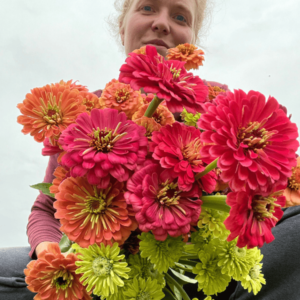
However, I think last year I planted them on May 10th, and the last frost is usually around May 15th. But because it takes a good three or four days until the seeds pop up above ground, the timing works. I planted them that day, knowing that the soil was warm, even though the forecast said it was going to get down to 30 degrees that night, and there was nothing below 35 or 36 at night in the 10-day forecast after that night. Then after that first 10 days, the forecast was all above 40. So, I went for it and popped them in the ground.
A couple of years ago, I also planted them on May 10th because there was nothing below 40 degrees in the 10-day forecast. Then, all of a sudden, Memorial Day Weekend, it was going to get down to like 28. So, I actually took an overhead sprinkler and I had it going all night. I think I turned it on at midnight so that the water was going back and forth over the plants. That literally just warmed up the air temperature enough (just a couple of degrees) so that they didn’t freeze. My basil, my zinnias, and my amaranth all survived. I did not put it on the snapdragons because they’re cold hardy. That was year two of growing. It was about six months after my husband had passed away (he passed away in December), and I was seven months pregnant, so I was just living on a prayer and growing flowers as therapy, and they didn’t die, so that was cool. Zinnias cannot tolerate frost.

So, you’re going to drop them in the ground as seeds, and when they start coming up, give them about three weeks. When they’re about 18 inches tall and have two sets of true leaves on them, you’re going to pinch them. So, to explain further … there’s the stem, then there’s the first couple of leaves of every plant that are not like real leaves, and then the next set of leaves are significantly bigger, and then they’ll have a third set of them. So, above that first set of true leaves, you literally pinch them and just snap them off/break them off, and then it will cause it to branch.
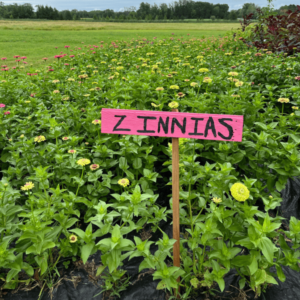
You are literally going to get twice the amount of flowers if you pinch them. Zinnias are a plant that is “cut and come again.” The more you cut them, the more they produce because it’s the plant’s job to go to seed and create another plant. Well, if you cut the stem low/if you cut off the flower, it’s going to think, “Oh, that didn’t work, we need to make another flower.” So, it will make another branch/another stem to produce another flower to try to pollinate, turn to seed, be happy, get married, go forth, and multiply.
They do kind of get tired, though, as the season goes on. So, I will succession plant them. Again, I will have planted the first round in mid-May. In theory, I will plant another round of them around June 1st and then probably another round around June 15th. In reality, I’ll probably plant the second round wherever some of my cooler-weather flowers, like stock were, when they are done blooming around the end of June, and then we can enjoy that second round of them toward the end of August and most of September.

For growth, they don’t need staking, they do okay without it. As I said earlier, I plant them in holes nine inches apart, and I’ll put two seeds in each hole. For the most part, I thin them out, but sometimes I just leave them because if they’re competing with each other, they’ll grow upward. Also, it seems like no matter what I end up doing, they get this powdery mildew on them. It makes the leaves get these blackish spots. The zinnias get it every year, no matter what I do. My recommendation is not to worry about it. It’s just the way it is. You’re going to remove those leaves to go into the vase anyway. I know every single flower farmer has this problem. If it’s in your landscaping, you’re going to put them in the back of your garden bed anyway.
If you’re thinking about buying pre-sprouted zinnias instead of direct-seeding, keep in mind that most of them that you buy from greenhouses are usually dwarf varieties. So, they are genetically modified to be shorter. The first year that I was going to do a cut flower garden, I bought eight four-packs. So that’s 32 plants at about $8 a four-pack – so $64 worth. When they grew, they ended up with only 6-inch stems. They’re meant for garden beds, pots, or borders of garden beds. Anyway, it was really funny. Luckily, I had also direct-seeded about 50 plants, so it was fine. But it was a lesson learned. I thought they were going to get me flowers sooner. But nope, that was a bust.

When I talk about harvesting them, I say that they are somewhat of a dirty flower. They give off a kind of slime, well, not really a slime, but they turn the water a little bit murky in a vase, similar to sunflowers. So, that’s why I tell my customers to change the water every day, especially if there are zinnias or sunflowers in the bouquet. I know it sucks, but change the water every day. It’s just what needs to be done. Some growers will end up putting a tiny bit of bleach into their water. I’ve never done this; I don’t know how well it works. The water can get somewhat dirty, but it’s not going to kill the other flowers in the vase, like honeywort, for example, which I found out the hard way last year. One week, all my subscriptions died within a day or two when I had honeywort in them, and everyone reached out, and I gave them a free new bouquet, which was fine. For some flowers, you need just to let them sit for a while and don’t recut the ends. Zinnias are not one of those, but they will still make the water a little bit murky, so you change out the water frequently.
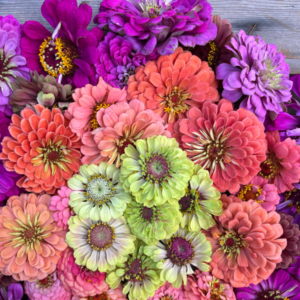
When you’re going to harvest them, you’re going to do what’s called the “wiggle test.” So, you take the plant about 12 inches below where it’s blooming, and you just kind of shake it back and forth. If it really flops side to side, it is not mature yet. It’s not ready to be picked yet. It’s just going to go to one side, and it’s not going to look good. So, you need to wait until it’s fully opened and stiff. However, if the flower itself is starting to pollinate, which you can tell because the center part starts really spreading out and going to seed, that will be too far gone. You’ve got to find that sweet spot. For the most part, you actually do get about a two-day window with zinnias, which is really nice because, with some flowers, you get a two-hour window. Again, that’s a point for zinnias. It’s not so bad.
When you harvest them, they don’t like to go in a cooler. They don’t like my walk-in cooler, they don’t like a fridge. I usually leave those in just an air-conditioned room. Then I make the bouquets, and I add the zinnias last and then just leave the bouquets in the air-conditioned room once the bouquets are done. That makes it a bit of a challenge because I would love for people to just pick up their bouquets from the walk-in cooler. But since zinnias are such a workhorse for me, and they make the bouquets look so nice and so full, I just can’t imagine not having them, so I make it work.
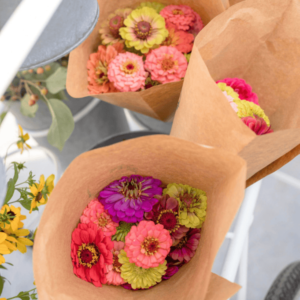
And they’re fantastic for you-picks. When people come out to the farm, the allure is being able to cut their own flowers, pick their own colors, pick stuff they like, and be able to stuff this big 32-ounce cup full of all the flowers they want, they’re not as concerned if some of the zinnias are flopping over a little bit and not perfectly sticking up. They look like wildflowers. They’re perfect. Nobody cares. They literally don’t care what their flowers look like when they leave because they’re having so much fun. It’s about the experience, not the product. So, I’m not so worried if people don’t do the wiggle test when they’re doing a you-pick event. Whereas if people are buying it the bouquets for the product, and I’m making them as subscriptions, I’ve got to make sure that they’re not going to flop over.
My three favorite varieties, and really the only ones that I grow, are the Benary’s Giant, Oklahoma Salmon, and Queen Lime. Benary’s Giant comes in every single color. I used to buy mixes, but it was the leftovers, so they’d be just all the leftovers shoved into a packet. There’d be a variety of colors like purple, white, yellow, red, or orange, maybe a few pinks, but not many. It was colors that most people didn’t want in their bouquets. They’re hard to mix with other colors and just don’t play well with others. So, for all of these zinnias, I now buy straight-color packets, not mixes.

For the Benary’s Giants, I will get those in a dark purple, lime green, and a salmon or pink color. They’re big! They can be about five inches across when they’re fully open. I really only need a couple of those in a bouquet, and they just look beautiful. They’re a focal flower.
Oklahoma Salmon is probably my favorite. They make almost this dome-like or cone-like shape when they bloom, and there are a lot of layers to the petals. Where the Benary’s Giant is just this big, kind of flat outer circle, the Oklahoma Salmon creates this dome shape. For the most part, I get them in the blush pink or the salmon color. Oklahoma is the variety.
The last variety I love that works really well is the Queen Lime. I love them for their colors. I wish the Oklahoma Salmon shape came in these colors. Someone needs to crossbreed them, and it’ll be perfect. I’m sure in 10 years, it’ll exist. One of the colors the Queen Lime comes in is Queen Lime Red, which is not red, they’re absolutely not red. I don’t grow red flowers because they don’t mix well with others. These are actually this pink color with lime green in the center. When Lindsay painted this mural, she did one of these Queen Lime Red colored zinnias. They also come in a really pretty blush pink, a purplish green, and a straight lime green. These are probably my favorite to mix with, like different color amaranth or deep purple status. What I love about them is that these Queen Lime zinnias can be so summery, or they can feel like fall, and they really mix well with a lot of different colors. So those are the three Zinnias that I grow.

Abbey, do you have any thoughts on zinnias?
Abbey: I was today years old when I realized what a zinnia is, and they are very pretty. One of the first things that comes up when you search Zinnia on Google Images is actually the Queen Lime Orange variety. And it’s gorgeous – there’s a lot of layers to that thing.
Liz: Yeah, exactly. So right now, there’s a lot of breeding happening with zinnias. As I said, people think of the garden center ones or the mixed seeds because they’re cheap and easy to grow, so many gardeners do them. People have been growing zinnias forever, but not a lot are being grown to be used in things like weddings, for florists to use, for event work, or anything like that because the colors are so weird. So, Erin Benzakein from @floretflower on Instagram is like the Joanna Gaines of flowers. She has these new Zinderella and Golden Hour varieties. She’s literally been breeding these zinnias for years. They’re kind of fluffy in the middle, kind of like peonies, actually.
Abbey: They’re so fluffy!
Liz: They look like dahlias. And they come in so many different colors. I’ve heard a lot of skeptics saying they’re pretty for weddings, but they’re not great for things like subscriptions. So, I’m getting married on October 6, 2023, and I am growing my own flowers for my wedding. I’m working with a florist because I’m not going to design and make my own bouquets, but I’ll be growing them and helping pick them on Tuesday, Wednesday, and Thursday. I was worried that I was too far ahead of time, but my florist said, “Liz, we don’t care about vase life. We need them to look nice on Friday.” And I said, “Oh, well, maybe we could donate the flowers when we’re done.” And she said, “They’ll be dead by Sunday or Monday.” I was like, “Oh, okay.” I’m used to picking them immediately before they’ll be picked up/sold. They are fresh, and I want people to enjoy them in their homes. Event work is a whole different ball game.
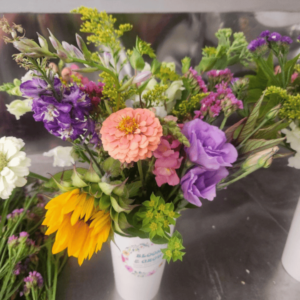
Abbey: You enjoy them for six hours.
Liz: Yeah, exactly. And then and then they’re done. So, I think that’s what these new zinnias are designed for. There’s a lot of more blush & pink colors. I think there’s one she calls Precious Metals zinnias or something like that. I haven’t bought any of them. I also don’t listen to her podcast or read her blog – zinnia breeding doesn’t really interest me enough. I’m not going to do the things that she grows them for, like premium event work, so it doesn’t really apply to me. It’s cool, but it’s not going to work for me. A lot of people that grew them last year that could get their hands on the seeds found out that they just don’t work for subscriptions.
Abbey: Neutrals are how I would describe them.
Liz: Yep, so it’s different compared to what the traditional zinnia looks like. I think there’s a lot of room to be worked on with vase life and all of that with zinnias. So, it’s very exciting to see what’s happening in the world of zinnias. They’re not your grandma’s flowers anymore.
Abbey: They’re really not. It almost feels like there could be a TLC show about this, like crossbreeding them and marketing them.
Liz: Oh, yeah. Zinnias also don’t ship super well because they can get so bent up if you bunch them all together. There’s this whole movement on locally grown flowers right now. And I think there’s huge perks to that, and that’s one of the reasons why. Flowers like zinnias, cosmos, and dahlias don’t ship well, and florists can’t get them. So, it’s very interesting to see what the zinnia world is going to look like in the future.
Thanks for reading the Sunny Mary Meadow blog. If you like what you’re reading, please subscribe to the podcast and rate us. You can also find us on Instagram, Pinterest, and Facebook.
You can subscribe to our email newsletter below. We love to hear any podcast-related feedback at our email podcast@sunnymarymeadow.com, and all other inquiries can be sent to liz@sunnymarymeadow.com.